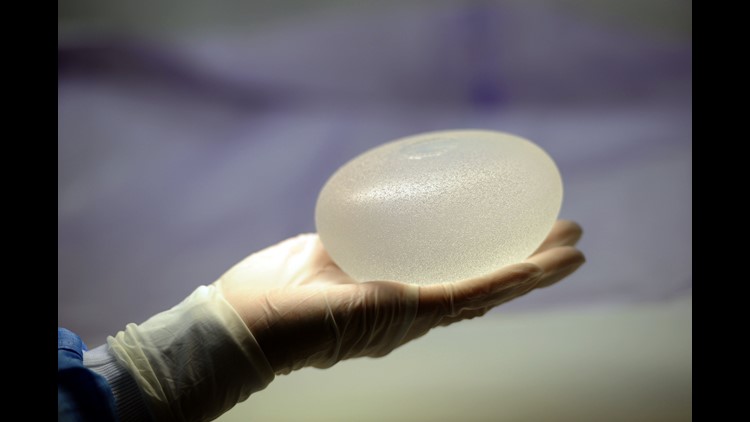Despite an outcry from women to ban a particular type of breast implant associated with a rare cancer, the sale of those implants will be allowed in the United States, the Food and Drug Administration announced Thursday.
Women considering breast implants will soon receive more strongly worded warnings about the dangers of the products before they decide to have the surgery, and the agency will continue to study the issue.
At a two-day public advisory meeting in late March, a number of women spoke out about their health problems after receiving breast implants.
One significant risk for women with implants is the development of implant-associated anaplastic large cell lymphoma (BIA-ALCL), a type of non-Hodgkin lymphoma, which is a cancer of the cells of the immune system.
BIA-ALCL is predominantly associated with a textured type of implant, rather than the smooth version. The illness is slow-growing and treatable when it’s detected early.
At least 457 women in the United States have been diagnosed with the cancer, according to the FDA, and nine have died as a result. The cancer affects cells in the immune system and can be found around the breast implant.
Acknowledging that international health agencies have been moving to ban the sale of textured implants, the FDA says the market share in those countries can reach 80%, while market share in the United States is tiny in comparison.
“The type of macro-textured implants targeted by some of our international counterparts represents less than 5% of breast implants sold here,” the agency said in a statement. “At this time, the FDA does not believe that, on the basis of all available data and information, the device meets the banning standard set forth in the Federal Food, Drug, and Cosmetic Act.”
The lack of action is disappointing, said Jamee Cook, co-founder of Breast Implant Victim Advocacy, who attended the FDA’s public meeting.
“Not banning the textured implants is very discouraging to us and to the patients who have lymphoma,” Cook said. “We’re going to continue to push for that ban, even though that’s not a move they are willing to make yet.”
About 10 million to 11 million women in the world have breast implants, according to the American Society of Plastic Surgeons and the Plastic Surgeon Foundation.
The FDA raised the possibility of the illness in 2011, saying there was a small but significant risk of the cancer after getting breast implants. It asked doctors whether they’d noticed changes in their patients and urged women to check for symptoms such as fluid buildup or a mass around their implants. Symptoms of the cancer also include swelling and redness around the breast implants.
Since that report, the scientific community has learned more about the link between breast implants and anaplastic large cell lymphoma.
Improving warnings
Besides BIA-ALCL, the agency said it was concerned about the risk of implant rupture and a condition called capsular contracture, in which the breasts become hard and misshapen, causing chronic pain, and an increase in immune system disorders.
“We have heard from patients concerned that their implants may be connected to health conditions involving their immune system’s response to these devices, resulting in a variety of symptoms like chronic fatigue, cognitive issues, joint and muscle pain,” the FDA said.
While acknowledging that there was no “definitive evidence demonstrating breast implants cause these symptoms,” the agency said that the fact that many immune issues disappear when the implants are removed meant “women considering a breast implant should be aware of these risks.”
Labeling changes such as box warnings and a patient decision checklist could be some of the ways the agency communicates some of the significant health concerns associated with breast implants.
Those were key changes that Breast Implant Victim Advocacy wanted, Cook said.
“The FDA said they were just considering those actions,” she said, “but based on our conversations over the past few weeks, I really have high hopes they will pursue those.”
Cracking down on adverse-event reporting
Breast implant manufacturers will also face a significant change in how adverse events are reported, the FDA announced. In the past, manufacturers could provide a summary of any patients problems or concerns, but that method did not capture “unusual, unique or uncommon adverse events, which, in the case of breast implants, included BIA-ALCL,” the FDA said.
Moving forward, the manufacturers will be required to file individual reports on adverse events that will be made publicly available in the coming weeks, the agency said.
Device Events founder Madris Tomes, who developed a tool to search adverse events in the FDA’s database, said the action “was a step in the right direction.”
“It appeared that the summaries contained a lot of data that should have been made available before that meeting,” she said, adding that adverse data should never be withheld from the public.
The FDA also said it planned to increase its partnership with patients registry groups such as PROFILE, which collects data on patients with BIA-ALCL diagnosis, and the National Breast Implant Registry, which was established last year.
Though applauding the work of the registries in its statement, the FDA said that “more needs to be done to increase the number of health care professionals contributing to the registries and types of information collected by the registries.”
The agency pointed out that it was been monitoring the risks of breast implants since 2011 and and considers the issue a priority.



